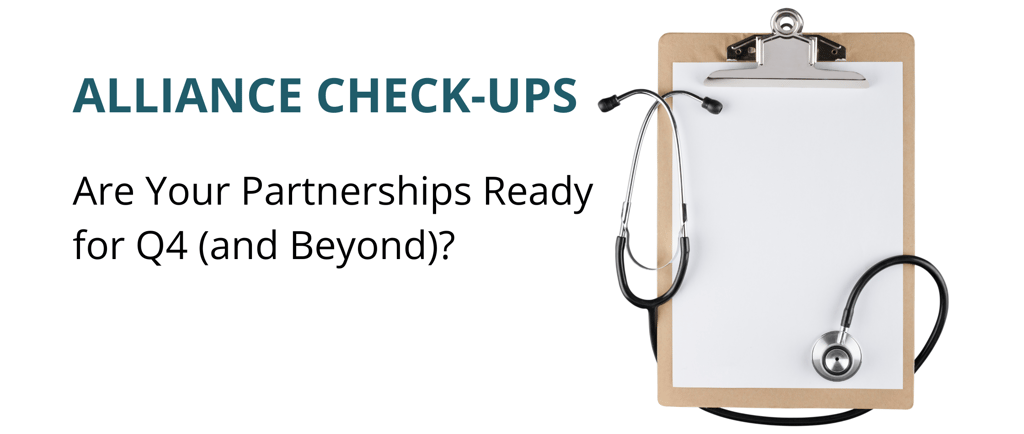Alliance Check-Ups: Are Your Partnerships Ready for Q4 (& Beyond)?
This post offers a practical framework to assess the health of your partnerships before year-end — complete with a downloadable Alliance Health Check-Up Checklist. Learn six vital signs of a strong alliance, red flags to watch for, and how to use Q4 as both a diagnostic period and a springboard for a productive 2026.
9/22/20253 min read


Partnerships are living systems — and like any system, they need regular checkups. Heading into Q4, even small misalignments can quietly erode value and create friction just when your teams need to be aligned and moving fast.
This is your opportunity to catch issues early, reset expectations, and finish the year strong — or at least enter 2026 with a clear, shared plan to fix what’s not working.
Vital Signs of a Healthy Alliance
Aligned Objectives: Both partners agree on what “success” looks like, and that definition hasn’t drifted from the original business case.
Clear Roles & Resources: Every deliverable has a named owner and is adequately resourced. No one is stretched too thin or left unclear on expectations.
Single Point of Contact (Alliance Lead): A clearly identified alliance manager or lead connects the dots across all functional teams — supply chain, forecasting, clinical, regulatory, legal, and marketing. This person ensures outcomes from subcommittees are captured and shared, risks are flagged early, and timelines remain visible.
Communication Rhythm: Meetings happen at a predictable cadence and are productive. No surprises, no endless status updates without decisions.
Performance Visibility: Milestones, KPIs, and risks are visible to both partners. Progress is transparent and there are no hidden spreadsheets.
Mutual Engagement: Both partners are equally invested. No one feels they are carrying the entire relationship or being left in the dark.
Red Flags to Watch For
• Misaligned objectives — partners drifting toward different definitions of success.
• Ownership gaps — deliverables multiplying with no one accountable.
• Milestone drift — deadlines slipping quietly with no recovery plan.
• Communication breakdown — canceled or ineffective meetings, delayed responses.
• KPI drift — each partner measuring success differently.
• One-sided effort — engagement or resourcing skewed heavily to one side.
How to Course-Correct Before Year-End (and Set Up 2026 for Success)
1. Run a Quick Alliance Review: Even a 30-minute pulse check can surface hidden issues — the goal isn’t to fix everything today, but to know exactly where you stand.
2. Reconfirm Shared Objectives: Agree on what can still realistically be achieved in Q4 and what needs to roll into 2026. Make this a key agenda item for your Q4 Joint Steering Committee.
3. Identify Missed Deliverables: Document what hasn’t been completed and why — so your JSC can decide what to recover and what to reforecast.
4. Close Resource Gaps (Where Possible): Reassign owners or free up missing resources now — or escalate resourcing needs in the JSC meeting.
5. Build a Strong 2026 Action Plan: Use the JSC session to align on a recovery plan and lock it into next year’s roadmap.
6. Clarify the Point of Contact: Assign or confirm your alliance lead, or add this to your JSC agenda if one doesn’t exist.
7. Reset Communication Cadence: Agree on meeting frequency and format during the JSC to set expectations going into next year.
8. Celebrate Quick Wins: Recognize team contributions at the JSC to re-energize both sides.
Don’t Skip the Q4 Joint Steering Committee Meeting
If you have a formal alliance governance structure, Q4 is the most important JSC meeting of the year. Use it to:
Review what worked — celebrate achievements and reinforce trust.
Surface what didn’t — be candid about missed deliverables, resource gaps, and timeline drift.
Align on what can be addressed in Q4 versus what should roll into 2026 plans.
Confirm priorities, funding, and resource commitments for next year.
If your alliance doesn’t have a JSC, Q4 is the perfect time to establish one. Form a cross-functional leadership group, agree on a charter, and hold your inaugural meeting before year-end. This one action can completely change the trajectory of your alliance in 2026.
Real World Insight
I’ve seen alliances completely turn around with one focused reset conversation — the kind where everyone leaves with a clear action list, renewed accountability, and shared excitement about finishing strong. The key is having someone in the alliance lead role who can keep that momentum going once the meeting ends.
Final Thought & CTA
Q4 isn’t too late — it’s the best time to re-align and set the tone for next year.
If you’d like a little extra guidance — or even a neutral third party to run a rapid Alliance Health Check — SynergyLM can help your team gain the clarity and energy it needs to finish the year strong and set up a productive 2026.
Start by downloading the Alliance Health Check-Up Checklist to see where your partnerships stand today. If you’d like help interpreting your results or turning them into a concrete action plan, send us a note or connect with me on LinkedIn — we’ll start with a conversation to understand your partnership challenges and explore next steps together.
SYNERGYLM, LLC
liz.michael@synergylm.net
7901 4th St. N #25825
St. Petersburg, FL 33702
© 2025. All rights reserved.


